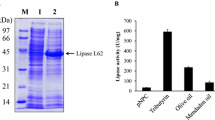Abstract
The ability of the commercial lipolytic enzyme Lipoprime 50T to catalyze the biotechnologically important synthesis of the biodegradable and environmentally acceptable trimethylolpropane (2-ethyl-2-(hydroxymethyl)-1,3-propanediol) ester of oleic acid was investigated. Simple and accurate thin-layer chromatography and computer analysis methods were used that enable one to follow changes of all reaction mixture components simultaneously. The processes of transesterification and esterification were compared. The effects of the molar ratio of the substrates, reaction temperature, time, and medium on the composition of the reaction mixture were analyzed. Esterification was determined to be more preferable than transesterification in both studied solvents. Under the optimal conditions identified (15% w/w water, temperature 60°C, trimethylolpropane to oleic acid molar ratio 1:3.5, and reaction time 72 h), the highest trimethylolpropane trioleate yield of around 62% and trimethylolpropane mono-, di-, and trioleate overall yield of about 83% were obtained. Although the yields are not high enough for industrial application, the process shows the potential to be optimized for higher yields in the near future as the conversions were obtained at ambient pressure, whereas many other processes described in the literature are conducted under vacuum at a specific pressure.




Similar content being viewed by others
References
Bendikienė V, Šinkūnienė D, Kiriliauskaitė V, Juodka B (2008) Properties and immobilization of Enterobacter aerogenes 13 lipase. Rom Biotechnol Lett 13(5):1–8
Bendikienė V, Surinėnaitė B, Juodka B, Bachmatova I, Marcinkevičienė L (2005) The specificity of Pseudomonas mendocina 3121–1 lipase. Hydrolysis. Biologija 1:27–30
Bendikienė V, Surinėnaitė B, Juodka B, Safarikova M (2004) Insights into catalytic action mechanism of Pseudomonas mendocina 3121–1 lipase. Enzyme Microb Technol 34:572–577
Dharma RK (2002) High performance ester lubricants from natural oils. Ind Lubr Tribol 54:165–170. doi:10.1108/00368790210431718
Hernaiz MJ, Sanchez-Montero JM, Sinisterra JV (1997) Influence of the nature of modifier in the enzymatic activity of chemical modified semipurified lipase from Candida rugosa. Biotechnol Bioeng 55:252–260. doi:10.1002/(SICI)1097-0290(19970720)55:2<252:AID-BIT2>3.0.CO;2-H
Li L, Du W, Liu D, Wang L, Li Z (2006) Lipase-catalyzed transesterification of rapeseed oils for biodiesel production with a novel organic solvent as the reaction medium. J Mol Catal Part B: Enzym 43:58–62. doi:10.1016/j.molcatb.2006.06.012
Linko YY, Tervakangas T, Lämsä M, Linko P (1997) Production of trimethylolpropane esters of rapeseed oil fatty acids by immobilized lipase. Biotechnol Tech 11(11):889–892. doi:10.1023/A:1018410316231
Royn D, Daz M, Ellenrieder G, Locatelli S (2007) Enzymatic production of biodiesel from cotton seed oil using t-butanol as a solvent. Bioresour Technol 98:648–653. doi:10.1016/j.biortech.2006.02.021
Ryu HS, Kim HK, Choi WC, Kim MH, Park SY, Han NS, Oh TK, Lee JK (2006) New cold-adapted lipase from Photobacterium lipolyticum sp. nov. that is closely related to filamentous fungal lipases. Appl Microbiol Biotechnol 70:321–326
Surinėnaitė B, Bendikienė V, Juodka B, Bachmatova I, Marcinkevičienė L (2002) Characterization and physicochemical properties of a lipase from Ps. mendocina 3121-1. Biotechnol Appl Biochem 36:47–55
Uosukainen E, Linko Y-Y, Lämsä M, Tervakangas T, Linko P (1998) Transesterification of trimethylolpropane and rapeseed oil methyl ester to environmentally acceptable lubricants. JAOCS 11:1557–1563. doi:10.1007/s11746-998-0094-8
Wang L, Du W, Liu D, Li L, Dai N (2006) Lipase-catalyzed biodiesel production from soybean oil deodorizer distillate with absorbent present in tert-butanol system. J Mol Catal Part B: Enzym 43:29–32. doi:10.1016/j.molcatb.2006.03.005
Wilson B (1998) Lubricants and functional fluids from renewable sources. Ind Lubr Tribol 50:6–15. doi:10.1108/00368799810781274
Yunus R, Fakhru’l-Razi A, Ooi TL, Biak DRA, Iyuke SE (2004) Kinetics of transesterification of palm-based methyl esters with trimethylolpropane. J Am Oil Chem Soc 81:497–503. doi:10.1007/s11746-004-0930-7
Zhang X, Schmidt M, Murrenhoff H (2002) Ageing mechanisms of ester based lubricants. Ölhydr Pneum 46(4):1–16
Acknowledgments
The Research Council of Lithuania (Contract No. PBT-07/2010-2) is gratefully acknowledged for financial support and we thank Biopolis Ltd, the distributor of Novozymes A/S in Lithuania, for the kindly provided enzyme.
Author information
Authors and Affiliations
Corresponding author
Rights and permissions
About this article
Cite this article
Kiriliauskaitė, V., Bendikienė, V. & Juodka, B. Synthesis of trimethylolpropane esters of oleic acid by Lipoprime 50T. J Ind Microbiol Biotechnol 38, 1561–1566 (2011). https://doi.org/10.1007/s10295-011-0946-3
Received:
Accepted:
Published:
Issue Date:
DOI: https://doi.org/10.1007/s10295-011-0946-3




